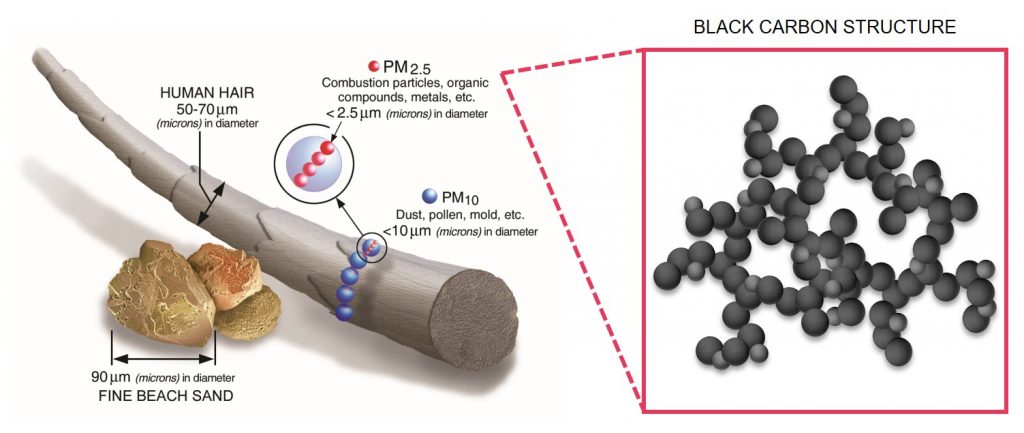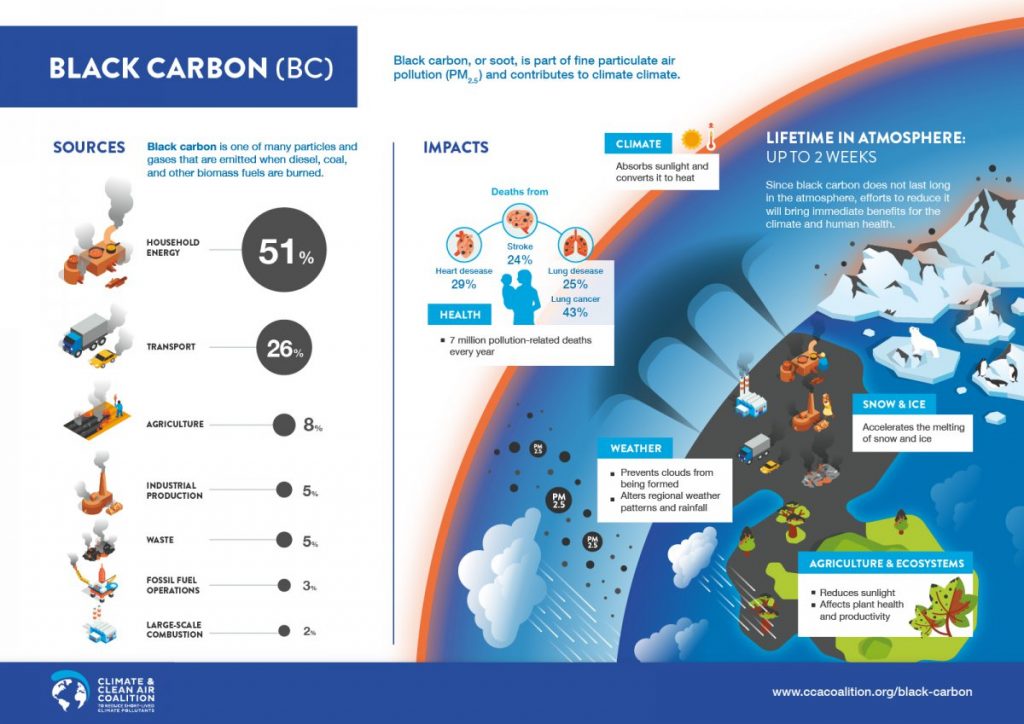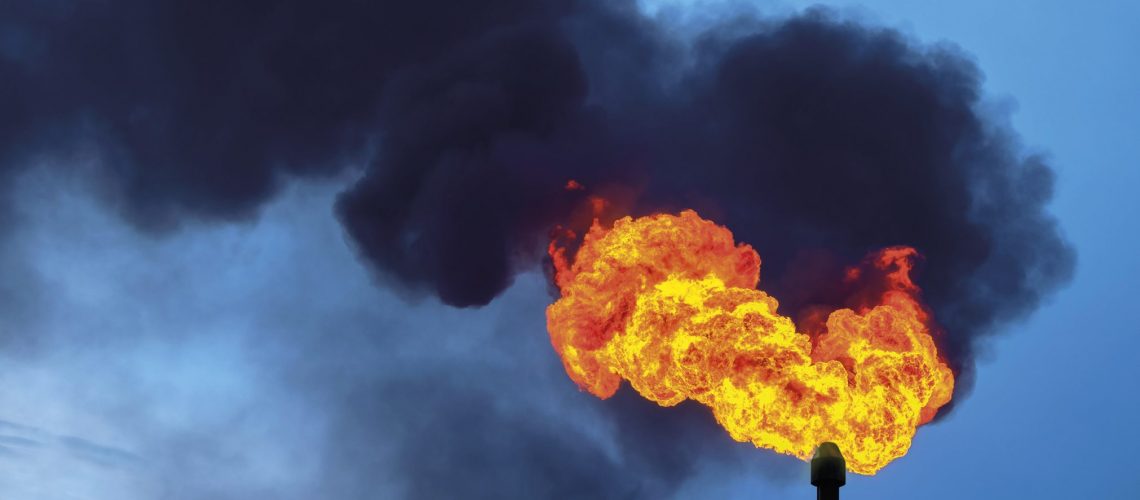Guest Post By Erin Boedicker, 2020-2021 Sustainability Leadership Fellow and Ph.D. Candidate in the Department of Chemistry
You’re driving down the road on a beautiful day, maybe your windows are down and you’re listening to your favorite music. From behind you hear a sudden sputtering sound and an old car passes by, leaving you in a black cloud of exhaust. As you drive through the plume left by the old car you may wonder, what exactly did I just drive through? That car exhaust is filled with particles and gas pollutants that have serious health and environmental impacts, often collectively called soot. But one pollutant in particular stands out in my mind when I see these plumes left behind: black carbon.
Black carbon is one type of airborne particulate matter (PM), which is a title for all the microscopic solid and liquid particles suspended in our air. When fuels are burned to create energy in a process called combustion, black carbon along with carbon monoxide and other compounds are created because there is not enough oxygen in the atmosphere for the reaction to go to completion. Whenever there are combustion processes, of which there are many in our industrial society (e.g., vehicles, cook stoves, oil and gas processing, and wildfires to name a few), there will be black carbon. The reason why black carbon is so relevant to health and climate science is because of its unique physical properties: it strongly absorbs visible light, it is insoluble in water, and it is tiny – anywhere from 10s to 100s of times smaller than a human hair! (Figure 1) These properties are a double-edged sword: while they are the root of the problems that black carbon causes, they also make mitigating black carbon one of the most actionable ways to fight climate change.

Direct Environmental Effects
Did you know that black carbon is the second most important warming agent in our atmosphere behind carbon dioxide (CO2)? This is because of black carbon’s enhanced ability to absorb visible light; it actually absorbs nearly a million times more energy per unit mass than CO2. Compounds that can absorb energy are important because they alter the radiative balance of our Earth’s atmosphere. This balance describes how much energy is being reflected back into space versus how much is being absorbed by our atmosphere; a positive change in the balance indicates that we’re taking more energy in (net warming) and a negative balance indicates that we’re reflecting more energy out (net cooling). Net atmospheric warming is problematic for a number of reasons – it leads to crop and vegetation stress which threatens our food security, it causes more intense dry seasons which lead to bigger wildfires that cause severe economic and environmental damage, and it leads to rising oceans levels which threaten existing infrastructure. Not only does black carbon contribute to atmospheric warming, it also contributes to surface warming because it is predominantly removed from the atmosphere by falling out in precipitation or settling naturally on surfaces. When it settles on plants, black carbon negatively affects plant productivity and health; when black carbon settles on snow- and ice-covered surfaces, it significantly accelerates melting.
Interactions and Indirect Environmental Effects
Clouds are a beautiful feature of our atmosphere, but they also have an important role: cooling. I’d guess almost everyone living in temperate or tropical latitudes has a memory of being outside on an incredibly hot day and having a moment of absolute relief when a cloud passes over. The reason it feels cooler is because those big white clouds are reflective. Clouds form when water in the air condenses onto tiny particles (around 300 times smaller than a human hair!) to form droplets. This process relies on the ability of water to interact with those tiny particles. But black carbon is hydrophobic, meaning that interaction with water is not going to come easily. When black carbon does act as a starting particle for cloud formation, it can alter the lifetime and properties of the cloud that incorporates it. The effects of this are still not fully understood and depend on many environmental factors. In some cases, the black carbon can make the cloud more reflective, but it also can limit cloud lifetime and decrease rainfall in the long run.
Health Impacts
Did you go outside this summer when the fires were happening in Colorado? Or have you ever been in a city on a particularly hazy day? I hazard a guess that your breathing probably felt different when you did. Outdoor air pollution accounts for approximately 3.7 – 4.8 million deaths globally (Cohen et al. 2017). Particles that are less than 2.5 µm in diameter, which include our black carbon particles of interest, have been shown to be particularly problematic because they can penetrate deep into the lungs and blood stream and cause cardiovascular and respiratory disease (Pope and Dockery, 2006; Brook et al., 2010). On top of this, some recent studies have found that the negative health effects of black carbon and other combustion particles may be worse than other sources (Janssen et al. 2011), and the World Health Organization has recommended evaluating a separate health standard for black carbon exposure independent of other particle concentration measurements (World Health Organization 2012).
Using Black Carbon to our Advantage
Right now, you’re probably thinking that our situation with black carbon is pretty bleak; it is warming our Earth’s surface and atmosphere, has problems getting along with clouds, and on top of all of that, is hurting our health. But there’s a bright side to our black carbon problems: it doesn’t live very long. Black carbon’s lifetime is on the order of days to a couple weeks, which is about 0.004% of the lifetime of other pollutants like CO2 (which has a lifetime of 300 – 1000 years). This means that if we focus on limiting black carbon emissions, we will see very fast improvements in our atmosphere and health. This is especially true if we focus on black carbon emissions in environments that are most affected by its presence, like regions with large amounts of snow and ice cover.
Initiatives targeting black carbon have already developed amazing and innovative solutions. Take the Arctic Circle, a region that contributes around 10% of global black carbon emissions but whose emissions are responsible for 30% of the warming effects in the region (Arctic Monitoring & Assessment Program 2015). In a place that is warming twice as fast as the rest of the world (National Oceanic and Atmospheric Administration 2020), mitigation of warming agents is crucial. The Arctic Council, which has representatives from the eight countries within the region as well as six indigenous communities, established the Arctic Contaminants Action Program (ACAP) working group to develop solutions to the pollution problems faced in the region. In October 2020, the group presented a comprehensive outline of economically viable best practices for the oil and gas sector (the largest source of black carbon in the Arctic) that could help reduce the emission of short-lived climate pollutants, including black carbon, by up to 70% by 2025 (Arctic Council 2020). Other amazing strides have been made in targeting black carbon emissions such as, the Environmental Protection Agency’s (EPA) Black Carbon Diesel Initiative in the Russian Arctic. The international initiative led a demonstration project showing that economically viable improvements could be made through vehicle replacements and engine retrofits to minimize black carbon emissions. These changes would lead to both climate benefits and improve the health of the surrounding community (US EPA 2014; Murmansk State Technical University 2020; Evans et al. 2015). The United States Forest Service has also carried out thorough studies on black carbon transport to the Arctic in an effort to minimize the effect of black carbon emissions from wildfire and agricultural burning (US Forest Service Research & Development 2012). This project suggested that refocusing activities like prescribed burns to these periods when long range transport does not occur can greatly reduce the impacts of the black carbon emitted. These efforts are a great start to reducing the overall effects black carbon on our planet, but even more can be done to implement the proposed solutions. Focusing on controlling a short-lived pollutant, like black carbon, and the compounds that increase its harmful effects can further help us provoke positive and fast-acting changes for our planet.

References
Arctic Council. 2020. “Significant Economic and Environmental Gains Can Be Achieved by Applying Best Available Technology in the Oil Sector in the Arctic.” Arctic Council. June 25, 2020. https://arctic-council.org/en/news/best-available-technology-in-the-oil-sector-in-the-arctic/.
Arctic Monitoring & Assessment Program. 2015. “AMAP Assessment 2015: Black Carbon and Ozone as Arctic Climate Forcers.” 2015. https://www.amap.no/documents/doc/amap-assessment-2015-black-carbon-and-ozone-as-arctic-climate-forcers/1299.
Brook Robert D., Rajagopalan Sanjay, Pope C. Arden, Brook Jeffrey R., Bhatnagar Aruni, Diez-Roux Ana V., Holguin Fernando, et al. 2010. “Particulate Matter Air Pollution and Cardiovascular Disease.” Circulation 121 (21): 2331–78. https://doi.org/10.1161/CIR.0b013e3181dbece1.
Climate & Clean Air Coalition. 2018. “Black Carbon.” Short-Lived Climate Pollutants. 2018. https://www.ccacoalition.org/en/slcps/black-carbon.
Cohen, Aaron J, Michael Brauer, Richard Burnett, H Ross Anderson, Joseph Frostad, Kara Estep, Kalpana Balakrishnan, et al. 2017. “Estimates and 25-Year Trends of the Global Burden of Disease Attributable to Ambient Air Pollution: An Analysis of Data from the Global Burden of Diseases Study 2015.” The Lancet 389 (10082): 1907–18. https://doi.org/10.1016/S0140-6736(17)30505-6.
Evans, M., N. Kholod, V. Malyshev, S. Tretyakova, E. Gusev, S. Yu, and A. Barinov. 2015. “Black Carbon Emissions from Russian Diesel Sources: Case Study of Murmansk.” Atmospheric Chemistry and Physics 15 (14): 8349–59. https://doi.org/10.5194/acp-15-8349-2015.
Jacobson, Mark Z. 2001. “Strong Radiative Heating Due to the Mixing State of Black Carbon in Atmospheric Aerosols.” Nature 409 (6821): 695–97. https://doi.org/10.1038/35055518.
Janssen, Nicole A.H., Gerard Hoek, Milena Simic-Lawson, Paul Fischer, van Bree, Leendert, ten Brink, Harry, Keuken, Menno, et al. 2011. “Black Carbon as an Additional Indicator of the Adverse Health Effects of Airborne Particles Compared with PM10 and PM2.5.” Environmental Health Perspectives 119 (12): 1691–99. https://doi.org/10.1289/ehp.1003369.
Murmansk State Technical University. 2020. “Arctic Black Carbon: Reduction of Black Carbon from Diesel Sources – МГТУ.” Murmansk State Technical University. April 27, 2020. http://eng.mstu.edu.ru/international/projects/closed-25012013.shtml.
National Oceanic and Atmospheric Administration. 2020. “Arctic Report Card: Update for 2020.” Arctic Program. 2020. https://arctic.noaa.gov/Report-Card/Report-Card-2020.
Pope III, C. Arden, and Douglas W. Dockery. 2006. “Health Effects of Fine Particulate Air Pollution: Lines That Connect.” Journal of the Air & Waste Management Association 56 (6): 709–42. https://doi.org/10.1080/10473289.2006.10464485.
US Environmental Protection Agency. 2014. “Black Carbon Diesel Initiative in the Russian Arctic.” US EPA. March 26, 2014. https://www.epa.gov/international-cooperation/black-carbon-diesel-initiative-russian-arctic.
US Environmental Protection Agency. 2016. “Particulate Matter (PM) Basics.” US EPA. April 19, 2016. https://www.epa.gov/pm-pollution/particulate-matter-pm-basics.
US Forest Service Research & Development. 2012. “Mitigating Arctic Black Carbon Deposition – Research Highlights.” 2012. https://www.fs.fed.us/research/highlights/highlights_display.php?in_high_id=74.
World Health Organization. 2012. “Health Effects of Black Carbon.” 2012. https://www.euro.who.int/en/publications/abstracts/health-effects-of-black-carbon-2012.
Zhang, Renyi, Alexei F. Khalizov, Joakim Pagels, Dan Zhang, Huaxin Xue, and Peter H. McMurry. 2008. “Variability in Morphology, Hygroscopicity, and Optical Properties of Soot Aerosols during Atmospheric Processing.” Proceedings of the National Academy of Sciences 105 (30): 10291–96. https://doi.org/10.1073/pnas.0804860105.
Zhang, Yuxuan, Xin Li, Meng Li, Yixuan Zheng, Guannan Geng, Chaopeng Hong, Haiyan Li, et al. 2018. “Reduction in Black Carbon Light Absorption Due to Multi-Pollutant Emission Control during APEC China 2014.” Atmospheric Chemistry and Physics 18 (14): 10275–87. https://doi.org/10.5194/acp-18-10275-2018.






